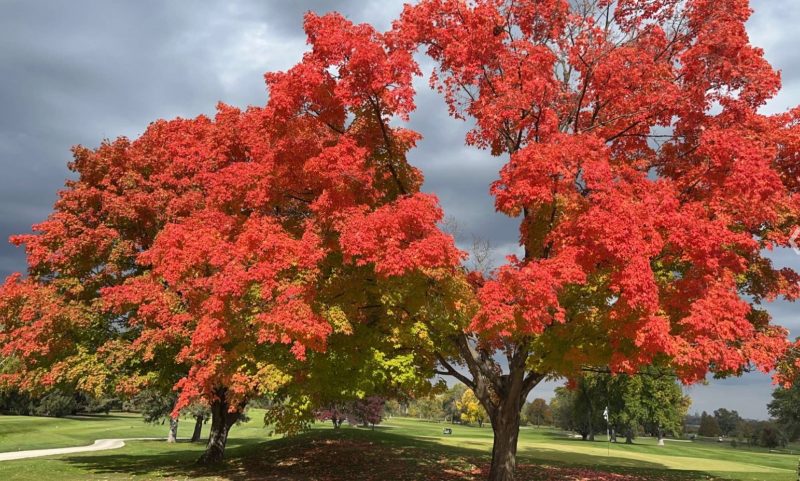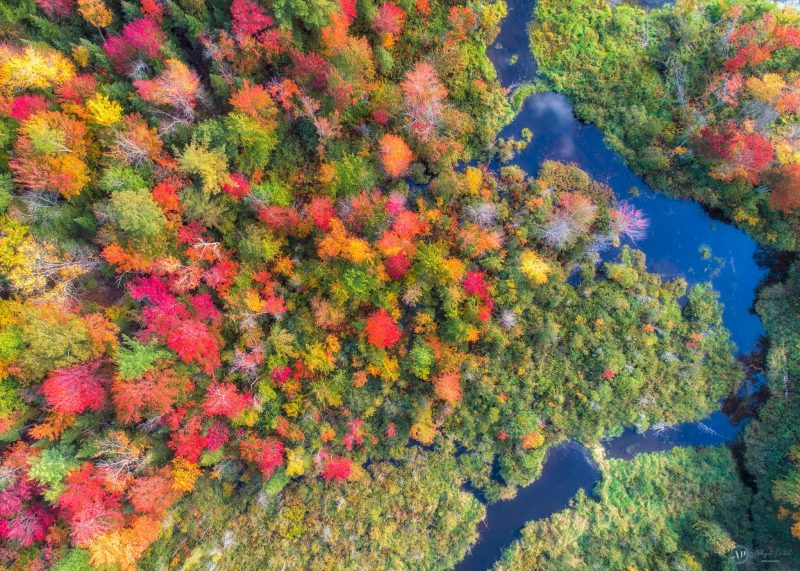EarthSky’s roving nature reporter, Kelly Kizer Whitt, spent October 3 to 5, 2024, at Minnesota’s North Shore, where the arrowhead of Minnesota meets Lake Superior. She hiked around and took in some of the area’s most popular sights, while the fall colors were at their peak. Watch a video that captures the best of this autumn explosion.
Why do leaves change color in the fall?
Throughout the spring and summer, the deep green color of chlorophyll, which helps plants absorb life-giving sunlight, hides any other colors present in the leaves of trees. Indeed, the vivid yellows and oranges of fall leaves are there, but hidden. However, in the fall, trees break down the green pigments and nutrients stored in their leaves. Then, the nutrients move into the tree’s roots for reuse in the spring. So, it’s then that the trees take on their autumn hues.
As leaves lose their chlorophyll, other pigments become visible to the human eye, according to Bryan A. Hanson, a former professor of chemistry and biochemistry at DePauw University who studies plant pigments. For example, some tree leaves turn mostly brown, indicating that all pigments are gone.

What brings out the reds in leaves?
Burgundy and red colors are a different story. Dana A. Dudle is a DePauw professor of biology who researches red pigment in plant flowers, stems and leaves. Dudle said:
The red color is actively made in leaves by bright light and cold. The crisp, cold nights in the fall combine with bright, sunny days to spur production of red in leaves, especially in sugar maple and red maple trees. Burgundy leaves often result from a combination of red pigment and chlorophyll. Autumn seasons with a lot of sunny days and cold nights will have the brightest colors.

Sometimes there is a mixture of colors when leaves change
Furthermore, in some cases, about half of a tree’s leaves are red/orange and the other half green. Dudle says that results from micro-environmental factors, such as only half the tree is exposed to sunlight or cold.
Hardwoods in the Midwest and on the East Coast are famous for good color selections. Some of the more reliably colorful trees, Hanson notes, are liquidambar trees (also called sweetgum) that turn a variety of colors on the same tree, and sometimes the same leaf. Ash tree leaves often turn a deep burgundy color. Ginkgo trees, although not native to North America, will feature an intense yellow, almost golden, color.
When leaves turn color they may be protecting the tree
The colors are doing something for the plant, or they wouldn’t be there, said Hansen. But what is the colors’ purpose?
Scientists think that with some trees, pigments serve as a kind of sunscreen to filter out sunlight. Hanson said:
It’s an underappreciated fact that plants cannot take an infinite amount of sun. Some leaves, if they get too much sun, will get something equivalent of a sunburn. They get stressed out and die.
Another theory is that the color of a plant’s leaves is often related to the ability to warn away pests or attract insect pollinators. Hanson said:
In some cases, a plant and insect might have co-evolved. One of the more intriguing scientific theories is that the beautiful leaf colors we see today are indicative of a relationship between a plant and insects that developed millions of years ago. However, as the Earth’s climate changed over the years, the insects might have gone extinct, but the plant was able to survive for whatever reason.
Because plants evolve very slowly, we still see the colors. So leaf color is a fossil memory, something that existed for a reason millions of years ago but that serves no purpose now.

Bottom line: Biologists discuss why leaves turn color in the fall.
Why don’t evergreen trees change colors and drop their leaves?
The post Why leaves change color. Plus, EarthSky spies peak fall color in northern Minnesota first appeared on EarthSky.
from EarthSky https://ift.tt/q7Legvn
EarthSky’s roving nature reporter, Kelly Kizer Whitt, spent October 3 to 5, 2024, at Minnesota’s North Shore, where the arrowhead of Minnesota meets Lake Superior. She hiked around and took in some of the area’s most popular sights, while the fall colors were at their peak. Watch a video that captures the best of this autumn explosion.
Why do leaves change color in the fall?
Throughout the spring and summer, the deep green color of chlorophyll, which helps plants absorb life-giving sunlight, hides any other colors present in the leaves of trees. Indeed, the vivid yellows and oranges of fall leaves are there, but hidden. However, in the fall, trees break down the green pigments and nutrients stored in their leaves. Then, the nutrients move into the tree’s roots for reuse in the spring. So, it’s then that the trees take on their autumn hues.
As leaves lose their chlorophyll, other pigments become visible to the human eye, according to Bryan A. Hanson, a former professor of chemistry and biochemistry at DePauw University who studies plant pigments. For example, some tree leaves turn mostly brown, indicating that all pigments are gone.

What brings out the reds in leaves?
Burgundy and red colors are a different story. Dana A. Dudle is a DePauw professor of biology who researches red pigment in plant flowers, stems and leaves. Dudle said:
The red color is actively made in leaves by bright light and cold. The crisp, cold nights in the fall combine with bright, sunny days to spur production of red in leaves, especially in sugar maple and red maple trees. Burgundy leaves often result from a combination of red pigment and chlorophyll. Autumn seasons with a lot of sunny days and cold nights will have the brightest colors.

Sometimes there is a mixture of colors when leaves change
Furthermore, in some cases, about half of a tree’s leaves are red/orange and the other half green. Dudle says that results from micro-environmental factors, such as only half the tree is exposed to sunlight or cold.
Hardwoods in the Midwest and on the East Coast are famous for good color selections. Some of the more reliably colorful trees, Hanson notes, are liquidambar trees (also called sweetgum) that turn a variety of colors on the same tree, and sometimes the same leaf. Ash tree leaves often turn a deep burgundy color. Ginkgo trees, although not native to North America, will feature an intense yellow, almost golden, color.
When leaves turn color they may be protecting the tree
The colors are doing something for the plant, or they wouldn’t be there, said Hansen. But what is the colors’ purpose?
Scientists think that with some trees, pigments serve as a kind of sunscreen to filter out sunlight. Hanson said:
It’s an underappreciated fact that plants cannot take an infinite amount of sun. Some leaves, if they get too much sun, will get something equivalent of a sunburn. They get stressed out and die.
Another theory is that the color of a plant’s leaves is often related to the ability to warn away pests or attract insect pollinators. Hanson said:
In some cases, a plant and insect might have co-evolved. One of the more intriguing scientific theories is that the beautiful leaf colors we see today are indicative of a relationship between a plant and insects that developed millions of years ago. However, as the Earth’s climate changed over the years, the insects might have gone extinct, but the plant was able to survive for whatever reason.
Because plants evolve very slowly, we still see the colors. So leaf color is a fossil memory, something that existed for a reason millions of years ago but that serves no purpose now.

Bottom line: Biologists discuss why leaves turn color in the fall.
Why don’t evergreen trees change colors and drop their leaves?
The post Why leaves change color. Plus, EarthSky spies peak fall color in northern Minnesota first appeared on EarthSky.
from EarthSky https://ift.tt/q7Legvn

Aucun commentaire:
Enregistrer un commentaire